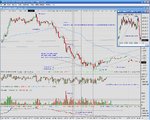And now I have the DNA I will clone you and put your doppelganger in front of the PC with unlimited curry from age seven upwards. :cheesy:
Thanks for responding again db.
dbphoenix said:
Of course. But you insert the word "rigid" as though it has some sort of moral value attached to it. There's nothing "rigid" about waiting for a lower high or a higher low. It's waiting for the market to tell you what to do.
Moral value? I'd wager that few philosophers have wrestled over the question "Was that act good, bad or rigid?", unless perhaps they were in a Stoppard play.
🙂 Anyway I'm not quite sure why I gave that impression or what you mean by it, but no matter.
No, I just mean the ordinary definition and I'm not talking about waiting for the market to trigger the setup (that requires nothing more than patience and discipline), rather the execution itself. Imagine a certain pattern is formed (or number of conditions are satisfied by the market's movement) that trigger the setup's entry signal. As you say either the setup criteria for that section of the trade are fulfilled or they aren't. That is what rigid criteria are and it is their blindness to which I object. Because of what I see as this flaw I don't think it is to my advantage to follow them slavishly in all conditions.
The "why" process is beyond the poor old setup's remit. Its job is to know when to act, not if the result of that action is likely to be profitable. Sure it may have been profitable 85% of the time in the past, nevertheless the criteria can only take account of fixed conditions (e.g did price make a HH after testing a BO level) without regard to the wider context that caused these conditions.
Indeed, you seem to agree, as you then say ...
Then you determine why the ones that work, work, and the ones that don't, don't. Either that or just jump in and hope for the best.
Discovering why is
precisely my quest and once one can do that with increasing skill then yes, the setups can be feedback > refined
up to the point of their intrinsic limitations, then taken or discarded, even adjusted on the fly, with discretion borne of experiential knowledge.
But incorporating all the finer nuances of market action effectively into a setup is a very hard task. There are some factors beyond the simple mechanics of price / volume etc. progression that simply cannot be fitted into a convenient box, because the market doesn't work in convenient boxes. The setup can capture what it seems as repeated conditions but it doesn't know if conditions are the same
beyond the superficial "map" presentation of them. Perhaps one day a neural net will manage this but I think it is beyond the logic programs available to us now.
The understanding and the rest of it come with trading well. If what you're doing is working for you, fine. If not, then consider a more disciplined approach. Not mechanical, not automated, not rigid. Just more disciplined.
No disagreement there.
On the other hand, given your use of the words passion and craving and so on, you may be expecting too many thrills for your own good, at least as a trader.
A passion for work and a craving for knowledge is imho useful if one is vigorously to keep climbing the percentile performance ladder and not to be confused with seeking thrills from the involvement with and outcome of a position, something I avoid like corduroy slacks.
Again, you're using words like confined and arbitrary and absolute. Are you associating all of this with defining a setup because you don't want to go through the process, or do you truly believe that this is what defining a setup means?
I've spent hour upon hour going through the process. I do actually believe the latter "this is what defining a setup means", at least at the moment, but I would love to be proved wrong. The way I see it, a setup is confined, by definition, as that is what makes it a setup not a vague "Oh it's going up i might buy now". A setup depends on absolutes that do not mesh well in an arena that does not (consistently) deal in absolutes. It's like applying Newtonian physics to the weather ... you are in for a surprise like Mandlebrot. A setup is surely nothing more than a series of logical IF THEN BUT NOT OR etc. conditions? Do x when y if z and not b or c given p 5 minutes ago.
Do you see the definition of setup differently (you must do), perhaps able to incorporate chaos, fuzzy logic, visual mathematics, adaptation to conditions that are very hard to express in language etc.? . If you do then I see why we are at cross purposes.
I actually think we agree but express ourselves differently. A semantic itch if you like.
Either you know what a higher low looks like in real time or you don't. If you don't, then you have to characterize it somehow. If you can recognize it only in hindsight, it's not going to do you much good. Actually, none.
Of course I do, as it will print on the chart and T&S clear for all to see. But a HL, for instance, is only the present physical manifestation of the sum total of motives and actions of the various groups of market participants and thus not every HL is equal, even if the setup must (even given a few extra fixed parameters) treat them as such for its purposes. If it doesn't have to do this then please tell me where I'm going wrong with my definition of "setup" and how you manage to encompass every subtlety of the market ocean into a rule based system. Again, a genuine question not an aggressive challenge, even it it comes across that way; if so I apologise. I'm here to learn db.

